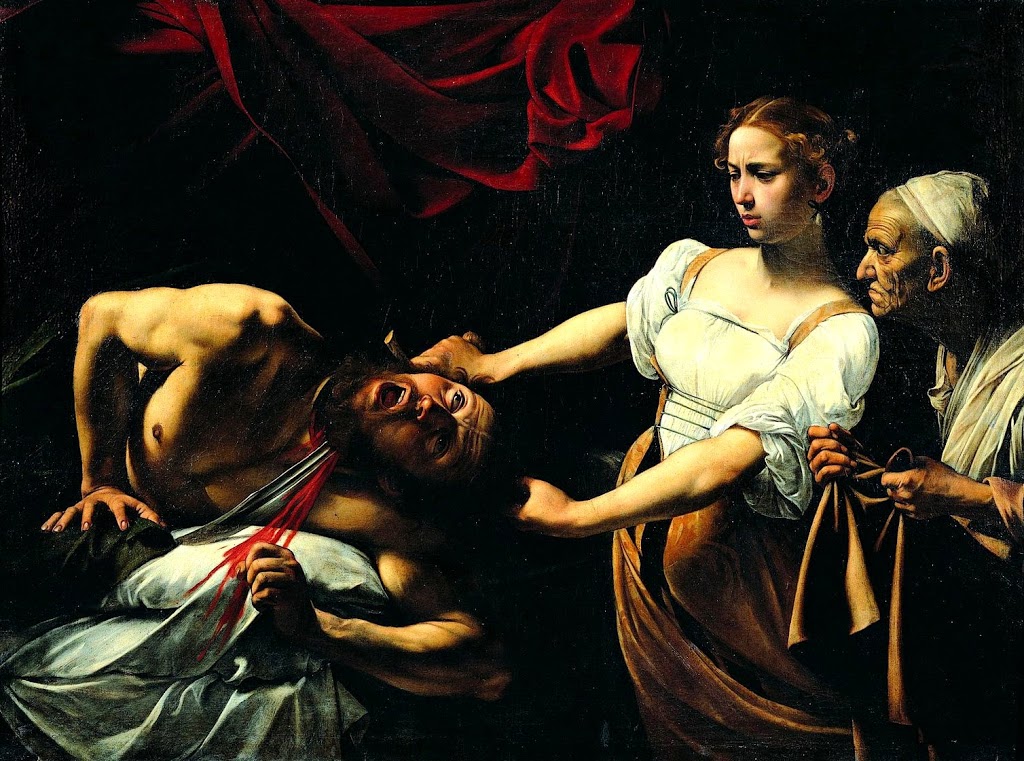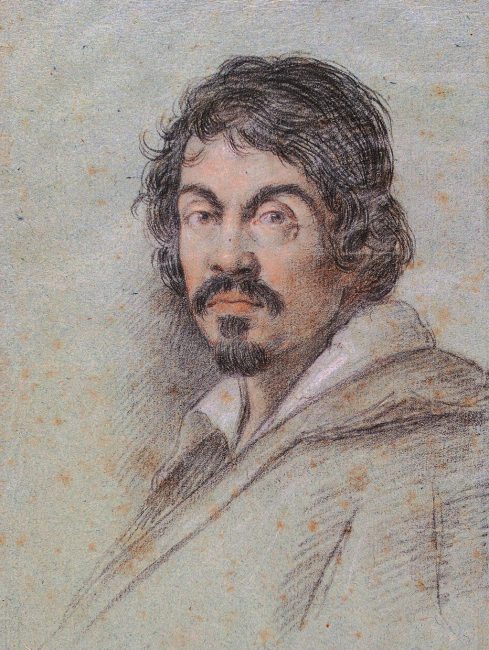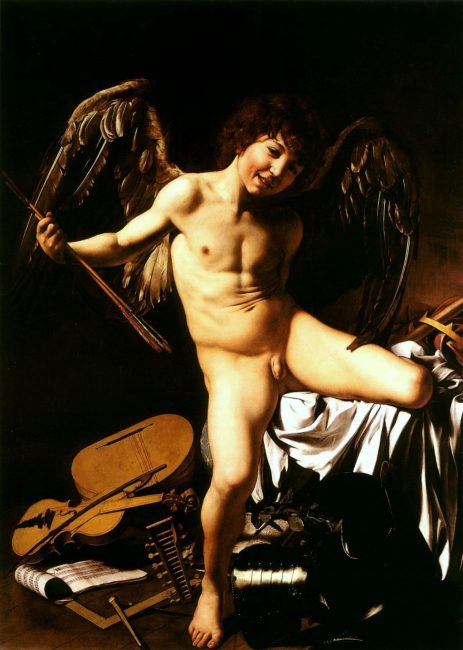
Judith and Holofernes by Michelangelo Merisi da Caravaggio, (1598)
On September 28, 1573, Michelangelo Merisi da Caravaggio, genius Italian artist of the Renaissance was born in Milano. He was best known for his realistic paintings with a dramatic appearance of lighting.
Un Unpredictable Character
The sources of Michelangelo Merisi’s life are extensive, but not yet fully researched. His first biographer was the Sienese art lover Giulio Mancini, who was a friend of Caravaggio’s first patron, Cardinal Francesco Maria Bourbon Del Monte (1549-1627), and who had treated Caravaggio in his household. His notes, which he had completed in 1619, were never published during his lifetime, but they circulated in transcripts and were known to other biographers and art writers. Among them was Giovanni Baglione, an enemy and rival of Caravaggio, who 32 years after his death published a biography (1642) in which he presented his former opponent as an unpredictable character with distortions of fact and subtle defamations.

Posthumous portrait of Caravaggio by Ottavio Leoni, c. 1614, Bibliotheca Marucelliana, Florence
Michelangelo Merisi da Caravaggio – Early Years
Michelangelo Merisi da Caravaggio was the son of Fermo Merisi, an independent master bricklayer from Caravaggio, a town near Bergamo, and his second wife Lucia Aratori, whose family owned smaller estates. Caravaggio was named after the Archangel Michael, whose name feast coincided with his date of birth. Michelangelo first grew up in Milan. Due to a plague epidemic in 1576 the family returned to Caravaggio, the father and an uncle probably succumbed to this disease. In 1584 the thirteen-year-old Michelangelo began a four-year apprenticeship with the famous painter Simone Peterzano in Milan. Peterzano, according to his own statements a student of Titian’s, worked for the high aristocracy of Milan. The not inconsiderable apprenticeship money was raised by the family.
At the latest in 1592 he settled penniless in Rome. There he first found accommodation with a prelate, Pandolfo Pucci, but, according to his early biographers, he soon left because of the modest and down-to-earth (frugal) meals. He worked in various painting workshops, including the studio of Giuseppe Cesari, the artist preferred by Pope Clement VIII. Initially in charge of flowers and fruit, he was able to learn in the workshop of his famous colleague. Presumably it was there that he met Prospero Orsi, a colleague specialised in painting grotesques, who was to become Caravaggio’s most important advocate and his agent on the art market.
In one of the workshops he became friends with Mario Minniti, a Sicilian who was six years younger and also a painter. Their friendship lasted from the spatial separation until Caravaggio’s death. After a few years, Caravaggio went into business for himself and joined the Brotherhood of Painters. Prospero Orsi was very likely to help him. He not only provided him with accommodation in the palace of Monsignor Fantino Petrignani, whom he had left to his nephew during a long absence from Rome; he also arranged for his brother-in-law Gerolamo Vittrici, the deputy papal treasurer, to buy three paintings by Caravaggio.
Finding a Powerful Patron
After the art-loving and influential Cardinal Francesco Maria Bourbon Del Monte became aware of Caravaggio, he probably took him in at the end of 1595 as a member of the household (the famiglia) in his Palazzo Madama. For about five years he lived in Del Monte’s palace. He was then admitted to Palazzo Mattei, the household of Cardinal Girolamo Mattei and his brothers Ciriaco and Asdrubale. The number of aristocrats and ecclesiastical dignitaries who commissioned paintings from him grew by leaps and bounds. Among them was Cardinal Scipione Borghese, the nepot of Pope Paul V and founder of Villa Borghese with the collection of paintings at Galleria Borghese.
The orders for two funeral chapels (Cappella Contarelli in the church of San Luigi dei Francesi and Cappella Cerasi in the church of Santa Maria del Popolo) made his style known to a wider public. The resulting fame brought him new orders and contacts with the wealthy and established his status as one of the city’s leading painters. Many popular artists followed his style then increasing Caravaggio’s fame tremendously.
A few paintings then followed, discussing the topics death and torture that he had to repaint due to his realism, which was sometimes not accepted in this period, but in contrast his tendency to dramatic intensity was appreciated. Caravaggio transformed into a very polarizing and highly discussed artist, often broaching the issue of religion and mixing it with other topics like science or ‘displacing’ religious symbols in his pictures. For instance the ‘Crucifixion of Saint Peter‘ shows the saint on the ground while presenting his horse’s hind end in the center, which was sharply criticized.

Caravaggio: Amor Vincit Omnia (1601/1602)
Manslaughter
Caravaggio’s involvement in a violent confrontation with manslaughter led him to flee Rome in 1606. During a street festival on the anniversary of Paul V‘s papal election on 28 May 1606, he and Onorio Longhi got into a quarrel, in which he wounded Ranuccio Tomassoni, son of the commander of Castel Saint Angelo, which served as a state prison, so badly that he died shortly afterwards. Caravaggio was at first only a minor character with regard to the cause of the dispute, because he only wanted to help his friend Longhi in the dispute between Longhi and the Tommasoni. The fatal outcome of the dispute was based on an older dispute, the causes of which were, however, the subject of differing statements from the sources. All those involved in the violent dispute were sought, sentenced and exiled by arrest warrant.
Neaples and Malta
Caravaggio himself had been seriously injured in the sword fight. After his wounds had been treated, he packed up the most necessary utensils in his quarters and went with his young assistant Cecco to the neighbouring palace of the Colonna family who were protecting him. The next morning he fled in their carriage to the Principality of Paliano, south of Rome, ruled by the Colonna family. In the autumn of 1606 he moved on to the Spanish Kingdom of Naples,
Caravaggio left Naples after a stay of about ten months and went on to Malta, where he was accepted as a celebrated artist and became a knight of the Order of Malta in 1608. The Order was subject to the Vatican, while the island was a Spanish fiefdom. Caravaggio had prepared the friendly reception presumably with picture gifts to high-ranking personalities. Nevertheless, his admission into the Order required a special permission of the Pope.

Caravaggio: Medusa (1597), Galleria degli Uffizi, Firenze
Back to Naples
His main work during his stay in Malta was the monumental painting The Decapitation of John the Baptist, his largest work. When the painting was unveiled, Caravaggio was in prison for being involved in a riot involving the injury of a knight. Without waiting for the trial to end, he fled prison and went to Sicily, where his friend from earlier years, Mario Minniti, lived. After less than a year he left Sicily and settled again in Naples, where he again worked for high-ranking clients. From a raid in Naples he suffered a severe facial injury. On the way from Naples to Rome he reached Porto Ercole, which belonged to the Spanish Stato dei Presidi, where he wanted to receive his pardon. Before it reached him, he died of sepsis on 18 July 1610 at the age of 38 in a hospital of Porto Ercole, where he was also buried.[8]
Chiaroscuro Painting
In the design of the scenes by the Chiaroscuro, the chiaroscuro painting, Caravaggio worked with a dramatizing use of obliquely incident, scatter-free bright light and created with the gestures and movements emphasized by light effects three-dimensionality, in which the figures were placed with unusual resemblance to life. In many of his paintings, Caravaggio has adopted gestures and details from the works of his great predecessors and competitors, among them first and foremost ancient sculptures, Michelangelo Buonarroti and Raphael, whose art, according to Giorgio Vasari, has fulfilled history. In his paintings, Caravaggio linked the processing of models (di maniera) with the representation of nature and models (alla prima).
Caravaggio was a great artist, sometimes ahead of his time and unafraid to affront people with his paintings. He worked largely alone and had no direct pupils. Nevertheless, his work had a lasting influence on Baroque painting: hardly any renowned painter was able to escape his influence in the years after his death. The most conspicuous features of the style known as Caravaggism and adopted were, on the one hand, “realism” in the unembellished everydayness of the scenes depicted, with the choice of the “dramatic moment shortly before or shortly after the climax“, and, on the other hand, his means of creating chiaroscuro painting with the effective shortening of the proportions in the composition. Only a hundred years after his death, Caravaggio was almost forgotten. He was rediscovered in the 20th century.
Rocky Ruggiero, Caravaggio: The Cursed Painter, [7]
References and Further Reading:
- [1] caravaggio-foundation.org 175 works by Caravaggio
- [2] Christiansen, Keith. “Caravaggio (Michelangelo Merisi) (1571–1610) and his Followers.” In Heilbrunn Timeline of Art History. New York: The Metropolitan Museum of Art
- [3] Caravaggio, Italian painter, at Britannica Online
- [4] Michelangelo Merisi da Caravaggio at The National Gallery
- [5] Caravaggio at WikiArt
- [6] Michelangelo Merisi da Caravaggio at Wikidata
- [7] Rocky Ruggiero, Caravaggio: The Cursed Painter, CA and NW Patrons of the Arts Vatican Museums @ youtube
- [8] Laura Geggel (28 September 2018). “Renaissance Master Caravaggio Didn’t Die of Syphilis, but of Sepsis”. Live Science.
- [9] Kimmelman, Michael (9 March 2010). “Caravaggio in Ascendance: An Antihero’s Time to Shine”. The New York Times.
- [10] Keith Christiansen (1990). A Caravaggio Rediscovered, The Lute Player. New York: The Metropolitan Museum of Art.
- [11] Timeline for Michelangelo Merisi da Caravaggio, via Wikidata






Hi there. firstly Caravaggio served his apprenticeship with Simone Peterzano who had a workshop in Milan. Caravaggio started his training there around the age of 12. his mother was still alive and she died when he was nineteen. Secondly Caravaggio never married. Angel. x
Thank you very much for your comment!
We did look up the information in the blog post at the references given below the post. Maybe these were not correct. Could you please give us some bibliographic reference for your corrections?
I just finished the blog. Really very helpful. Thanks for sharing such an amazing blog.
michelangelo marble